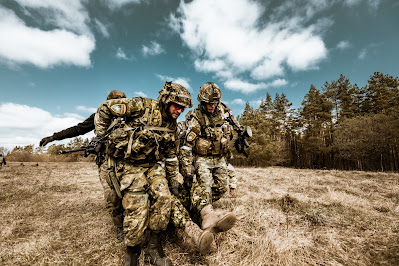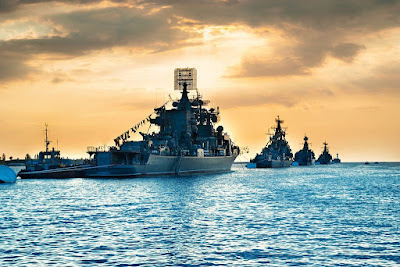How Ukrainian Armed Forces'
Success on Land and Sea: A Frontline Overview
Introduction
In recent weeks, Ukrainian forces have made significant strides in pushing back Russian advances both on land and at sea. This article provides an in-depth overview of the current frontline situation, highlighting the successes, challenges, and strategic implications of these developments. We draw insights from various
sources, including the General Staff, official statements, British intelligence, the American Institute for the Study of War (ISW), the Deep State project, and military experts to offer a comprehensive and easy-to-understand analysis.
Stalling of the
Russian Advance on the Lyman-Kupiansk Axis
The Russian advance along the Lyman-Kupiansk axis has encountered significant setbacks. Over the
past month, their progress has been limited to a mere 1-2 kilometers, and not consistently across the front. They have failed to capture any settlements during this period, resulting in a shift from offensive actions to a more static, positional warfare.
According to Illya Yevlash, Chief Spokesperson for the Eastern group, recent days have witnessed relative calm, marked by fewer direct clashes. The Russian focus has shifted towards artillery and aviation. The enemy seems to have abandoned its earlier offensive tactics, most notably near Novoiehorivka in the Svatove district of Luhansk region.
Analysts from the Deep State project have observed feeble attempts by the Russians to seize the
initiative near Novoiehorivka. They also noted the destruction of a storming column south of Novovodyane. Currently, the line of confrontation has stabilized, with the Russian forces experiencing significant manpower losses and slowing down their pace.
These heavy losses have compelled the Russians to alter their tactics. Instead of the previous "meat grinder" assaults, they are now relying more on artillery, albeit with reduced intensity due to the need to conserve ammunition. Nonetheless, reinforcements are on their way, and the Ukrainian Defense Forces
remain prepared for any developments.
The Russians have employed outdated weaponry, such as T-90 tanks and Solntsepek systems, which should have been decommissioned long ago. Moreover, they are grappling with personnel shortages, as highlighted by Yevlash.
Military experts, including Oleksandr Musiienko, agree that the Russian plans for a major offensive have failed. They were unable to divert Ukrainian reserves from the south, force Ukrainian troops into strategic defense, or achieve a breakthrough to the eastern bank of the Oskil River. Musiienko notes that the initiative now lies with Ukrainian forces, who are dictating the enemy's maneuvers.
The failure can be attributed to the ill-preparedness of the Russian troop groups deployed to this axis, labeled Center and West, which lacked the necessary equipment and capabilities for offensive operations across a wide front, particularly in breaching Ukrainian defenses.
Advancements South of Bakhmut
To the south of Bakhmut, the Ukrainian Armed Forces have achieved notable successes. They have made progress along the Klishchiivka-Andriivka-Kurdiumivka line, culminating in the liberation of two settlements in recent weeks.
The first of these victories was the liberation of Andriivka, announced by the General Staff on September 15. President Volodymyr Zelenskyy hailed this as a significant and much-needed result. Subsequently, the 3rd separate assault brigade raised the Ukrainian flag above the village.
The battles for Andriivka were particularly noteworthy, as Ukrainian forces managed to encircle and defeat the 72nd separate motorized rifle brigade of the Russian Federation, resulting in the elimination of a substantial portion of enemy infantry, officers, and commanders, including the brigade's intelligence chief.
On September 17, the 80th separate airborne assault brigade of the Armed Forces liberated Klishchiivka, providing a foothold for further advancements. This operation, spanning several months, underscores the determination and resilience of Ukrainian forces.
The southern flank, divided into the southwestern and southeastern sectors, is demarcated by the T0513 highway, stretching from occupied Bakhmut to Horlivka. Recent successes have occurred in the southwestern sector, with the Russian defensive line spanning Klishchiivka, Andriivka, and Kurdyumivka.
After the liberation of Kurdyumivka, the entire enemy defensive line in this sector is expected to fall under the control of the Ukrainian Defense Forces. The strategic significance lies in the last dominant heights located in the Klishchiivka area, which will compel the Russians to take positions in the lowlands, placing them at a disadvantage.
The eventual liberation of Kurdyumivka will open up the path to the southeastern sector, with a key point at Zaytseve. Although these victories represent tactical episodes, they set the stage for further eastward movement.
Notably, cutting off the Horlivka-Bakhmut highway will force the Russians to rely on alternative routes, increasing logistical challenges. However, the readiness for an operational encirclement of Bakhmut is still uncertain, given the significant concentration of enemy resources and their staunch resistance.
The Initiative Near Donetsk and Russian Advances near Maryinka
Following partial entry into the village of Opytne near occupied Donetsk, Ukrainian Defense Forces have maintained the initiative in the Avdiivka and Shakhtarsk directions.
Analysts from the American Institute for the Study of War (ISW) report limited ground strikes by Ukrainian forces, particularly near Krasnohorivka in the Avdiivka-Donetsk area.
Meanwhile, Russian attempts to advance near Maryinka continue. According to Oleksandr Shtupun, the spokesperson for the Unified Press Center of the Defense Forces of the Tavria direction, Russian assault troops launch attacks from 10 to 15 times daily.
Experts from the Deep State project do not report any significant changes in this area. Their data suggests that Russian attempts to improve the tactical situation have been largely unsuccessful, with Ukrainian artillery effectively destroying enemy observation posts in the Pervomaiske area.
While the Russians have persistently pushed toward Maryinka, they have failed to achieve significant results. Despite the town being nearly destroyed, their advances through ruins have been largely ineffective. However, they continue their efforts, albeit with little success.
In contrast, the situation in Opytne presents a different scenario. Ukrainian forces initiated a sudden attack, forcing the Russians to retreat. However, they have been unable to secure the settlement due to intense enemy artillery shelling. The Russians constantly counterattack, seeking to regain positions they held two weeks ago.
Developments in the
South and Kyrylo Budanov's Forecast
Amid the breakthrough of the first line of defense near the village of Robotyne, the Russians are preparing for a battle to secure Tokmak, a potentially critical point on the second line in the Zaporizhzhia region.
British intelligence reports indicate that the occupiers are deploying additional checkpoints, anti-tank obstacles, and digging new trenches in Tokmak. The intensity of their fortifications underscores the Russian command's concerns about a potential Ukrainian breakthrough in the south.
However, the Ukrainian Armed Forces may not have fully capitalized on their success, partially due to the enemy's reinforcement of positions. British intelligence estimates suggest that approximately 10,000 Russian paratroopers from the 7th and 76th Airborne Divisions have been dispatched to Robotyne as infantry reinforcements for their exhausted ground forces.
Oleksandr Musiienko views this as an attempt to hastily patch up holes in their defense lines. He notes that the uncertainty displayed by Russian units, despite their fortified positions, suggests doubts about their ability to hold these positions.
The Ukrainian counteroffensive might be slowed down by the indiscriminate use of paratroopers. According to Oleksandr Kovalenko, the primary task will be to neutralize this human resource before expanding Ukrainian footholds in the region. He emphasizes that the last dominant heights are located around Klishchiivka, compelling the Russians to fall back to the lowlands, placing them at a disadvantage.
Kyrylo Budanov, Chief of the Main Intelligence Directorate of the Ministry of Defense, envisions a scenario in which Ukrainian Defense Forces cut off the land corridor to Crimea before winter. He posits that the breakthrough of the Russian defense in multiple places is a prerequisite for this achievement, as
Russia lacks the strategic reserves to prevent it.
While Budanov's forecast is optimistic, its realization hinges on future developments in the coming weeks. The success of this endeavor will be influenced by battlefield achievements and the level of military aid provided by Western partners.
It's worth noting that the offensive in the south has liberated approximately 260 squarekilometers of territory since its inception.
Dealing a Blow to the Russian Black Sea Fleet
Ukraine delivered a significant blow to the Russian Black Sea Fleet with a missile strike on the Sevmorzavod shipyard in occupied Sevastopol. The strike, which occurred on the night of September 13, resulted in critical damage to the large landing ship Minsk and the submarine Rostov-on-Don. These vessels are likely out of commission, given the extent of the damage.
Commander of the Air Force Mykola Oleshchuk confirmed that the attack utilized British Storm Shadow missiles, known for their precision and effectiveness. Special operations forces coordinated the strike, approaching the shore on boats to reach a secure location, employing underwater means to access the coast, identifying targets, and initiating the attack.
In a separate operation, Ukrainian special forces utilized an experimental kamikaze drone named SeaBaby to disable the missile ship Samum near Sevastopol Bay. This operation was deemed highly successful by expert Vladyslav Seleznyov.
The damage inflicted on the Russian naval assets enhances security not only for Ukraine but also for international vessels navigating the Black Sea. The destruction of Russian ships, including missile carriers and landing ships, is a crucial objective that improves overall maritime security in the region.
Conclusion
The Ukrainian Armed Forces have displayed remarkable resilience and adaptability in countering Russian advances on land and at sea. Their successes in pushing back Russian forces, liberating key settlements, and delivering a significant blow to the Russian Black Sea Fleet mark significant milestones in this ongoing conflict.
While the situation remains fluid and dynamic, these developments underscore Ukraine's determination and capability in defending its homeland. The success of future operations will depend on resource capabilities, battlefield achievements, and international support, making it essential to closely monitor
evolving events in the coming weeks.











0 Comments